|
Cornus kousa 'Claudia' demonstrating how the bracts can mature from white to pink on some cultivars.
|
CORNUS ...
last updated 18/11/2023
|
Cornus kousa is the hardiest species in this group and in many ways the most suited to the rather damp British climate. It is widely distributed through East Asia, including Korea, China and Japan. Plants of this species also to be the most shade tolerant in the group and will thrive in a woodland situation. However, they can also be supremely effective as individual specimens and most (ie the green leaved selections, not the variegated cultivars) tolerate a sunny site, provided adequate soil moisture is retained in summer. They generally form a small tree, eventually up to around 5m. There are a great many cultivars available, giving scope for a wide range of habits. Some remain narrow and upright in habit, whilst others develop spreading branches which are smothered with flowers in June from almost the first year. Most years will see their peak floral display in June, which is later than the American dogwoods (ie the cultivars and hybrids of C. nuttallii (April) and C. florida (May)), so extending the season. The bracts are usually cream or white, although there are also pink bracted cultivars. Their shape varies from star-like where the bracts are narrower and more pointed, to quite rounded and even over-lapping. Typically they all unfurl as greeny star-shaped bracts initially, then open out and enlarge as they develop. In many of the white bracted cultivars, the bracts continue to mature to a rich pink, even to the extent of giving a bicolour effect. This is particularly evident where the bracts are exposed. ie this happens less where the bracts are protected within the canopy or the tree is growing in a shady environment. Many cultivars also boast wonderful autumn leaf colours in shades of oranges and reds. Variegated forms are available but they can be more difficult to grow, preferring a slightly more protected environment. We seldom propagate the variegated cultivars because our site is too exposed for them to thrive. Additionally, some forms freely produce very attractive large strawberry-like fruits. These are edible and apparently they make excellent jam or even wine. We now have a superb collection of these spectacular trees; although native to Asia, many recent varieties have come from the United States and Europe. Don't let the extensive range bewilder and befuddle you - feel free to email me for advice as to which cultivar will best achieve the effect you would like to have in your garden. It is important to purchase a grafted, named cultivar because they have all been selected as something rather special, with the important benefit of flowering from a younger age. The first decision is likely to be bract colour, but then consider the shape, habit and vigour of the tree that would suit the position. Please note that they are listed alphabetically by cultivar name (ie with no regard as to whether they are cultivars of Cornus kousa var. chinensis or not.) With differing opinions as to where some should be classified, I hope this makes it easier to find things. See also the deciduous Rutgers hybrids between Cornus kousa and Cornus florida, as well as the Semi-Evergreen hybrids. There are also a number of evergreen selections which are very closely related.
|
|
Cornus kousa 'Claudia' demonstrating how the bracts can mature from white to pink on some cultivars.
|
|
|
|
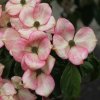 |
Cornus kousa
'Akabana' A pink bracted selection originating in Japan. Although there is considerable variation in shape between individuals, this one seems to naturally form a more symmetrical plant than the other pink bracted cultivars. |
|
|
|
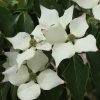 |
Cornus kousa
'All Summer' This is a particularly splendid form with a tidy and upright habit, with rich green foliage. Long lasting bracts as the name implies! See it in our Quarry Garden and Woodland Walk. |
|
|
|
| Cornus kousa
'Akatsuki' This is a variegated sport from 'Miss Satomi' which originated in Japan. The leaves are green with broad, irregular white margins. The deep pink bracts contrast well with the variegated foliage. Unfortunately, it is a comparatively weak plant which needs close to ideal conditions in order to thrive. As a result it is one that we rarely propagate. |
|
|
|
|
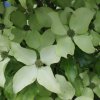 |
Cornus kousa
'Autumn Rose' This is a delightful American selection, whose bracts open light green before maturing to soft white. However, it is the foliage which makes this one unique - the yellow to lime green spring growth gives way to green wavy leaves in summer which develop myriad shades of pink to red autumn colours. It seems to lack the vigour of most kousa cultivars, which makes it suitable for small gardens although it does benefit from a kinder site. |
|
|
|
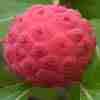 |
Cornus kousa
'Big Apple' Large spreading tree with heavy textured dark green leaves and extremely large fruit. |
|
|
|
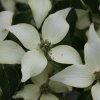 |
Cornus
kousa
'Blue Shadow' Another fantastic American selection which seems to be extremely robust. The leaves are larger and more substantial than most, being a rich bluish green in colour. Fantastic rich orange-red autumn colour. Long-lasting white bracts and fruit. Particularly heat tolerant. |
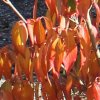 |
|
|
|
|
| Cornus kousa
var. chinensis 'Bodnant' The young stems are distinctly purple and the large creamy white bracts are freely produced. It also sets fruit freely. This one seems reluctant to make a symmetrical tree shape, so may be best grown in a more informal manner, effectively as a large shrub |
|
|
|
|
| Cornus kousa
'Bultinck's
Giant Flower' Available from autumn 2022 |
|
|
|
|
| Cornus kousa
'Cappuccino' The larger the collection one has, the harder it is to find something "different" and I am determined that we will not add to it just for the sake of collecting another name! Nor am I interested in growing things that may be "different" but for all the wrong reasons, making them of little ornamental merit. Of course sometimes it is necessary to grow something for a while to be able to see for yourself whether it is worthy of a place. Therefore I am particularly thrilled with this more recent selection and addition to our collection, which is without a doubt both "different" and worthy of a place in any garden. It is distinguished by rather lovely foliage, warmly flushed with coppery bronze tones all season. The prolific bracts are the typical shape, whilst the creamy colouring shows up beautifully against the darker foliage. This one also readily develops an elegant structure, making it a brilliant all-rounder. |
|
|
|
|
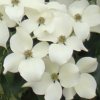 |
Cornus
kousa 'Cherokee' The dense form and compact habit make this one of the smaller growing kousas. It is extremely floriferous with wide, rippled bracts. Rich green foliage reliably develops good autumn colours, whilst fruit are also freely produced. A great introduction. See it in the Gardens here. |
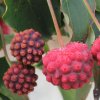 |
|
|
|
|
| Cornus
kousa 'China Dawn' A wonderful variegated selection with a broad, creamy white margin to the otherwise green leaves. I find that autumn colour is often particularly showy on the variegated forms as the different portions of the leaf turn colour at different rates. Although much more tolerant of exposure than the frankly fussy 'Snowboy', it is still best grown with some element of protection as so many variegated plants are. Due to the difficulties of our exposed site, we rarely propagate the variegated cultivars, so availability will be very limited. |
|
|
|
|
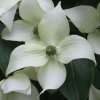 |
Cornus
kousa var. chinensis 'China Girl' Selected for prolific flowering with large creamy white bracts. The bracts actually start quite small, green and star-like and enlarge and whiten as the central true flowers mature. Unlike many cultivars, once these flowers are over, the bracts turn brown and drop, rather than turning pink, making this one a popular choice for themed "white gardens". Upright habit. |
|
|
|
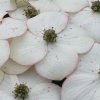 |
Cornus
kousa 'Claudia' I received this, and originally listed it, as 'Claudine', however I believe 'Claudia' is now the accepted name. It has become a firm favourite of mine, developing a broad, layered habit. These layers are covered in opulent creamy bracts of good substance which, in a more open position, will pinken as they mature. Lovely rich wine red autumn leaf colour is reliably produced (as is often the case, best colours will be seen in a sunny site) whilst fruit are prolific. See it in the gardens here. |
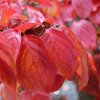 |
|
|
|
|
| Cornus
kousa 'Copacabana' Available from autumn 2022 |
|
|
|
|
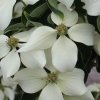 |
Cornus
kousa 'Doubloon' A tall, upright growing form which reliably forms an elegant, symmetrical small tree. An exciting American selection, it allegedly has additional bracts around each flower cluster giving a semi-double effect. However, its inclination to produce flowers thus is probably determined by climatic conditions, and it has never done so for us! Nevertheless, the plant is distinctive, with foliage that is unique in our collection for the fine silvery hairs covering the leaves and stems. |
|
|
|
| Cornus
kousa 'Dr Bump' Supposedly a compact selection, we acquired this one from the USA. However, we were sufficiently under-whelmed that we never propagated it. It is no longer in the collection. |
|
|
|
|
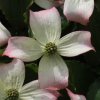 |
Cornus
kousa 'Dwarf Pink' A Japanese selection with narrow, pink bracts which pale towards the centre. The compact, bushy habit makes it a great choice for small gardens. Autumn leaf colour can be superb on this one, but it doesn't seem to produce much fruit. See it in our Quarry Garden. |
|
|
|
| Cornus
kousa 'Ed Mezitt' This American selection has purple new growth, with the leaves remaining bronze flushed until flowering time in June. The bright orange-red autumn colour can be excellent, whilst wide creamy bracts overlap to give good floral effect too. It has a rather lax, informal habit rarely, producing a single dominant leader. |
|
|
|
|
| Cornus
kousa 'Elizabeth
Lustgarten' This one has a distinctive habit - the leader is still upright, but the lateral branches weep to give a graceful, weeping, rounded crown. White bracts which pinken with maturity. We rarely propagate these truly weeping cultivars because they are so difficult to maintain; both in terms of keeping the plant looking tidy, but also the ground beneath it where weeding becomes so difficult amongst the dangling stems and foliage. |
|
|
|
|
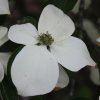 |
Cornus
kousa 'Fanfare' A rapid grower with an upright, vase-shaped, growth habit. The large creamy-white bracts are freely produced and autumn foliage colour is also attractive. Though perhaps less relevant in this country, it is reportedly particularly hardy, surviving temperatures as low as -29C. Nevertheless, this one has stood out in the collection here to become a firm favourite. See it in our Woodland Walk. |
|
|
|
| Cornus
kousa
'Fernie's Favourite' Thanks to Charles Fernie, previously of Grayswood Hill for this lovely plant, which we named and introduced on his behalf. Thought to be an original introduction from the wild, the creamy bracts become marked with distinct pink splashes. This can be a vigorous grower, typically developing a broad, free branching habit. In suitable conditions, rich red autumn leaf colours can be seen. |
|
|
|
|
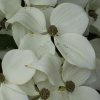 |
Cornus
kousa 'Galilean' An excellent selection, part of the "Biblical Series" from Jim Zampini of Lake County Nursery, Ohio. Impressive, with upright habit and enormous creamy bracts, broad and rounded at the base to give a much more substantial impression. This is a great choice where a more "tree-like" specimen is required. |
|
|
|
| Cornus
kousa 'Gay Head' This floriferous selection is compact, yet upright in habit. The white bracts are curved or ruffled and vary in size. |
|
|
|
|
| Cornus
kousa 'Girard's Dwarf' Previously known as 'Girard Nana', that name was not valid according to modern nomenclature rules since it mixed Latin and modern languages. This truly dwarf form is a deceptively heavy bloomer. |
|
|
|
|
| Cornus
kousa 'Gold Cup' Not to be confused with our old favourite 'Gold Star', this newer form is supposedly more vigorous and more upright in habit. I say supposedly because we haven't seen much evidence of this here! The foliage is similar being dark green with a prominent yellow central splash. |
|
|
|
|
| Cornus
kousa 'Gold Star' This Japanese selection has beautiful foliage, having a central yellow star in a dark green leaf. The starry white bracts are smaller and more sparsely produced than in most other cultivars. Particularly pretty red autumn colour is also highlighted by the variegation, whilst the red fruit contrasts superbly with the brightly coloured foliage. Unfortunately (in my opinion) it has a messy habit so we seldom propagate it. The long thin arching stems shoot out at seemingly random angles, creating a very tangled and structure-less mound. |
|
|
|
|
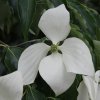 |
Cornus
kousa 'Greensleeves' A fast growing tree which develops a symmetrical branch structure and "vase-shaped" semi-upright habit. Extremely large bracts are held above the glossy foliage for maximum effect; these maintain a surprising amount of the initial green colouring except when grown in heavy shade. This is indeed one of the very best cultivars for floral effect. See it in our Quarry and Winter Gardens. |
|
|
|
| Cornus
kousa var. chinensis 'Greta's Gold' This form arose on our nursery many years ago as a chance sport. We named it after Greta our daughter, who at the time was just a baby! In the time since, we have improved the variegation and reliability by careful propagation. This plant is still special to us, as it was our first "new" plant. The young leaves have a bronzey tint, then open to a broad gold margin or splash. The autumn colour is fantastic with the variegation determining the shades of pink and red. |
|
|
|
|
| Cornus
kousa 'Highland' The bracts of this heavy bloomer are ivory white and the light green foliage is prettily ruffled. Broad habit. |
|
|
|
|
 |
Cornus
kousa 'John
Slocock' This is a fabulous selection and an absolute favourite of ours. The bracts mature a week or two earlier than our other kousas, which extends the season rather nicely. It bracts so heavily that it is an amazing sight; the bracts being creamy-white, with the potential to mature with pink splashes dependant on environmental conditions. The habit is distinctive too. It is naturally more compact than many, though bushy and natural-looking rather than formal or upright. Autumn leaf colours can be attractive and fruit freely produced, completing a brilliant all round package. See it above our Quarry Garden. |
|
|
|
| Cornus
kousa 'Kreuzdame' Large bracts are reliably produced, but for me its stand-out feature is its intense, bright orange autumn colour. It really is one of the best in this regard. It has a broad, layered habit. |
|
|
|
|
| Cornus
kousa 'Little Beauty' Originally selected from wild collected Korean seed, this form is supposedly dwarfer in all its parts once mature. Young plants growing strongly may have normal sized leaves. I'm yet to be convinced by this one so it is not currently in production. So far it has flowered very sparsely and to my eyes is of extremely limited ornamental merit. If a more compact selection is required, then in my opinion, there are a number of better options. Feel free to drop me through an email to discuss. |
|
|
|
|
| Cornus
kousa 'Lizzie P' I'm not sure what this American cultivar was selected for, but we were sufficiently underwhelmed that we never propagated it. It is no longer in the collection. |
|
|
|
|
| Cornus
kousa 'Lustgarten Weeping' A strong weeping form that can be trained up to give a true weeping tree or grown naturally to form a creeping, arching mound. The bracts are held nicely above the foliage. Potentially spectacular trained along a low wall or as edging in the same way as "step-over" fruit trees. We rarely propagate these truly weeping cultivars because they are so difficult to maintain. Both in terms of keeping the plant looking tidy, but also the ground beneath it where weeding becomes so difficult amongst the hanging foliage. |
|
|
|
|
| Cornus
kousa 'Madame Butterfly' The dainty white pointed bracts are said to resemble butterflies sitting on the branches as they turn up from their mid point. |
|
|
|
|
| Cornus
kousa var. chinensis 'Milky Way ' Another vigorous upright form, but this one has a distinct white mottling to the leaf. Beauty is in the eye of the beholder of course, but if I'm brutally honest, I don't much like the effect, so we seldom propagate it. |
|
|
|
|
| Cornus
kousa var. chinensis 'Milky Way Select' Although designated a cultivar, the background to 'Milky Way' is quite complex...suffice it to say that at one point in its history, it was more of a strain than a cultivar. Thus different clones with this name exist. We now have a selected form from the US which has typical foliage (as opposed to the mottling of our original clone above) and good bracts. For once I think it is not a case of "right" and "wrong", so much as "different". |
|
|
|
|
| Cornus
kousa 'Miss Petty' The slightly cupped leaves are the darkest green, some say almost black-green, contrasting well with white bracts which pinken with age. |
|
|
|
|
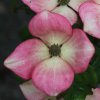 |
Cornus
kousa 'Miss Satomi' We originally imported this beautiful form from Japan over 30 years ago now. The dark pink flower bracts surround a central creamy eye. The bronzey foliage reflects the pink bracts, and develops lovely autumn colours. It is thought that temperature can influence the exact colour of the bract, so there is scope for variation in the intensity of pink. In my experience, it is richer in a more open site than it is in shade. As is typical of most of the pink bracted selections, the habit is informal and shrubby, rarely producing a dominant leader and thus rarely developing a tree-like shape. |
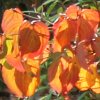 |
|
|
|
|
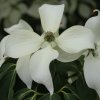 |
Cornus
kousa 'Moonbeam' A beautiful selection producing masses of large creamy white bracts which have been described as glowing in the evening sun. This one has a distinctive habit, being neither layered nor upright. Instead it forms a rounded head. The foliage is slightly different too, being flushed with copper tones. Another cultivar with lovely autumn foliage. |
|
|
|
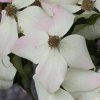 |
Cornus
kousa 'National' This magnificent cultivar is of dense, rounded habit and the large bracts are very freely produced. They open white, then deepen to pink as they mature. This gives an interesting bicolour effect across the whole plant and maximises the time of interest. It's almost difficult to believe that the two photos left were of the same plant, taken a couple of weeks or so apart. |
.jpg) |
|
|
|
|
| Cornus
kousa 'Nicole' Available from autumn 2022 |
|
|
|
|
| Cornus
kousa 'Ohkan' I find myself increasingly shying away from the continuing stream of variegated Cornus kousa cultivars becoming available. Yet this Japanese selection is definitely worth having. I can liken it to our own selection ‘Greta’s Gold’. The green and yellow variegation is clean and bright. The typical white bracts in June are followed by rich orange, red and purple autumn colour. Not a vigorous plant though so, as with most variegated plants, it is best when grown with some protection from the strongest sun and wind. |
|
|
|
|
| Cornus
kousa 'Peve Limbo' Introduced in Holland in 2001, this variegated clone has larger leaves and therefore greater vigour than most other similar selections. The foliage is irregularly margined creamy-white on dark greyish-green, with a yellow flush through the new growth. As with most variegated plants, it is best when grown with some protection. |
|
|
|
|
| Cornus
kousa 'Peve Satomi
Compact' From the same stable as 'Peve Limbo' above, as the name implies, this is a more compact pink bracted selection. Unfortunately it is so slow growing that it doesn't have the strength to survive our harsh conditions. Perhaps it would be a pretty plant in a pot or a very sheltered garden, but our experience suggests that it is not a good garden plant. |
|
|
|
|
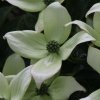 |
Cornus
kousa 'Pollywood' Named after Polly Hill of Massachusetts who selected it, the bracts are essentially white, but creamy towards the middle and subtly tipped with pink. Incredibly prolific, the bracts are produced slightly later than most other kousa cultivars and are very long lasting. With time it develops a wonderfully architectural broad and layered habit. Autumn foliage colour can be fabulous, and fruit are also freely produced. One of our favourites, so planted very prominently here. See it in our Winter Garden. |
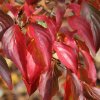 |
|
|
|
|
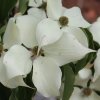 |
Cornus
kousa 'PVG' I imagine the cultivar name is the initials of the originator, probably first applied as a "working" name to identify it on the nursery, which then "stuck" as the plant was distributed. To my eyes this is a great plant and a worthwhile selection. I like the tidy, rather upright habit and the bracts are certainly as large and prolific as you could wish for. However, for me its "stand out" feature are the fruit, with it reliably producing some of the biggest and best fruit of any of our C. kousa selections. |
|
|
|
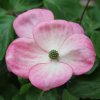 |
Cornus
kousa 'Radiant Rose' This stunning American cultivar continues to impress me with its beautiful large pink bracts, which are noticeably more rounded than many. The fruit are quite incredible too, being plentiful and large. I noted with interest that there is a surprising amount of difference between the fruit of various cultivars. Although ostensibly the same at first glance, these are very smooth, whilst others are quite bumpy. See it in our Winter Garden. |
|
|
|
| Cornus
kousa 'Rasen' Broad creamy white bracts are freely produced, overlapping and reflexing with maturity. Maturing as it does with a broad and layered habit, it is similar to 'Claudia', 'Kreuzdame' and 'Wisley Queen'. All of which also boast particularly reliable autumn leaf colours and prolific fruiting. |
|
|
|
|
| Cornus
kousa 'Rosemoor Pink' This material came from a very beautiful plant in Lady Ann’s garden at Rosemoor, which had clearly been there for many years. It is good to know that an identical replacement has been planted to replace it when the time comes. Lovely pink bracts, with the pigmentation evident through the purple flushed summer foliage. As is typical of most of the pink bracted selections, the habit is informal and shrubby, rarely producing a dominant leader and thus rarely developing a tree-like shape. |
|
|
|
|
Cornus kousa 'Saudade'This came to us as a cultivar of Cornus kousa. However, having grown it for a few years, I have become convinced that it is a hybrid with Cornus nuttallii. Click here to go to the full entry. |
|
|
|
|
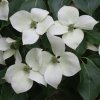
|
Cornus
kousa 'Schmetterling' A vigorous selection of upright habit, from the continent. Large bracts are freely produced. The habit and combined overall effect of this one has made it a popular choice for many who come here to compare the cultivars before making their selection. It perfectly fulfils the criteria of a really good garden tree. See it in our Winter Garden. |
|
|
|
| Cornus
kousa 'Sluis Slim' This recent addition to our collection is reputedly extremely upright and columnar. It is still a young plant, but early indications are certainly that this is the case. At the moment it is growing extremely slowly because it's in a rather harsh site, so it may be a while before we have this one available. Feel free to drop me through an email to enquire. I find this sort of shape extremely useful for bringing height to a small garden without taking up too much space, or being overly dominant at eye level. I'm looking forward to seeing how it develops. |
|
|
|
|
| Cornus
kousa 'Snowbird' A sturdy and compact form to little more than 3m, making it ideal for the smaller garden. The bracts may also be proportionally smaller, but somehow that just adds to its elegance. |
|
|
|
|
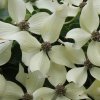 |
Cornus
kousa var. chinensis 'Snowflake' The name reflects the distribution of the flower heads and the graceful habit of the plant when in flower. Wrong season though! The starry bracts each have a distinctive wavy edge. This is an absolute favourite of mine, in part due to the way it consistently forms such a nicely shaped plant. The autumn colour shown in the photo (left) is typical, being quite distinctive, with shades of paler golds and oranges. See it in our Woodland Walk. |
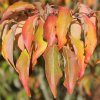 |
|
|
|
|
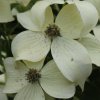 |
Cornus
kousa 'Snowflurries' There seems to be confusion as to whether the correct name for this one is 'Snowflurries' or 'Snow Flurry'. It's a European selection, but I can't find much info regarding its origin, either in literature or on the internet. It has quite a distinct habit; the stem structure being more angular and "V" shaped as opposed to a softer, more rounded "U" shaped framework. It seldom produces a dominant leader to give it a more traditional tree-shape, typically remaining bushy and free branching. It flowers profusely for us, so if you fancy snow flurries on your lawn in June, then this is the plant for you! |
|
|
|
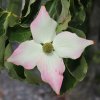 |
Cornus
kousa 'Southern Cross' Creamy white bracts mature through pink, starting with just a delicate pink tip. This extends their "flowering" time very satisfactorily. A delightful New Zealand selection, stocky when young, but becoming broader with age. Fabulous orange autumn leaf colours too. |
|
|
|
| Cornus
kousa var. chinensis 'Spinners' Selected by Peter Chappell at Spinners Garden for its profuse flowering. It has a reputation for peak bract production being biennial, though that may be a result of environmental influence. I'm sorry to say that we rarely propagate this one any more. |
|
|
|
|
| Cornus
kousa 'Square Dance' The distinctive large, creamy white bracts overlap to give the appearance of a "square" flower which is always commented upon. Upright growth habit and good autumn colour as well as large fruit. |
|
|
|
|
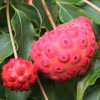 |
Cornus
kousa 'Steeple' As the name implies, this one is more upright in habit than many (but nowhere near to the point of being fastigiate), with lovely glossy foliage which colours well in autumn. Sharply pointed creamy bracts and splendid fruit. |
|
|
|
| Cornus
kousa 'Summer Majesty' Selected by Mitsch Nursery in Oregon, the prolific white bracts appear brushed with pink as they mature. It typically develops a layered habit, becoming as wide as it is high. |
|
|
|
|
| Cornus
kousa 'Summer Stars' The bracts are particularly long lasting, with the first fruits colouring as the last bracts fade. More purple autumn colours in the right conditions. However, it is its overall appearance that is perhaps the most defining feature of this one. It most closely resembles 'Tsukabanomine' with its compact, layered habit and smaller than typical leaves and bracts. |
|
|
|
|
| Cornus
kousa var. chinensis 'Temple Jewel' A floriferous selection which grows vigorously to form a distinctive vase-shape with dense branching habit. The new leaves are variegated with yellow centres, through lime green to a dark green margin, though this diminishes as the growth ripens. Although I describe this as variegated, the overall effect does not shout out at you in the way that variegation usually does. Indeed our display plant is in a completely open position, and the variegation is generally only apparent at close inspection. Instead it just appears to be a really handsome tree, with a profusion of bracts slightly earlier in the season than most other cultivars. See it in our Gardens here. |
|
|
|
|
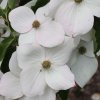 |
Cornus
kousa 'Teutonia' Most of our newer selections have come from the US, but this one is European. Large creamy white bracts as expected but it is the autumn colour which sets this one apart, even in a "poor" year. Translucent and fluorescent oranges with the light behind them are some of the best. This typically makes a tidy, slightly smaller tree. See it in our Gardens here. |
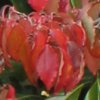 |
|
|
|
|
| Cornus
kousa 'Trinity Star' This one is unique in our collection. The young growth emerges bright pink, before developing white mottling as the leaves mature ultimately to rich deep green. It is compact and tidy in habit, making a splendid small tree that's just a little bit different. |
|
|
|
|
| Cornus
kousa
'Tsukubanomine' Such a distinctive plant. Horizontal branching habit, which creates an effect not unlike that of Viburnum plicatum. Much more exclusive though and quite different to most of the other Cornus in our collection. Small and narrow, pointed bracts perch on top of the thin branches. |
|
|
|
|
| Cornus
kousa 'Weaver's Weeping' A slow growing but true weeping form which needs support to establish a leader. The smaller bracts can be distinctly flushed pink. We rarely propagate these dwarf weeping selections though because they are so slow growing and difficult to maintain. We rarely propagate these truly weeping cultivars because they are so difficult to maintain. Both in terms of keeping the plant looking tidy, but also the ground beneath it where weeding becomes so difficult amongst the hanging foliage. |
|
|
|
|
| Cornus
kousa 'Whirlwind' As a young plant, the branches sweep spirally - looking as if they've been caught in a whirlwind! It does grow out of this eventually though. |
|
|
|
|
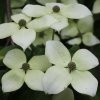 |
Cornus
kousa 'White Dream' A European selection with good-sized bracts produced prolifically. This one has a tidy habit, naturally forming an elegant vase-shaped small tree. Fabulous autumn leaf colours too. |
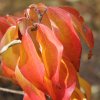 |
|
|
|
|
| Cornus
kousa 'White Fountain' An evocative name, justifiably conjuring images of fountains of white bracts. In principle, this is a vigorous small vase-shaped small tree, but the white bracts are produced in such profusion that they weigh down the branches, such that they gracefully arch at the tips. Not to be confused with the cultivar named 'Weisse Fontaine' (which translates to "white fountain") which is a truly weeping form of the type we no longer grow. |
|
|
|
|
| Cornus
kousa 'White Dusted' This is quite a pretty variegated selection, with slightly smaller leaves than is normal, delicately speckled with shades of cream. It is a slower and smaller grower, so needs a protected site. It lacks the vigour to grow through conditions less to its liking. As with many variegated selections, this was selected for its foliage, not its bracts, so the latter a rather small. Due to its weaker and delicate nature, we no longer offer this one, though we do maintain a collection specimen in a more shady area. |
|
|
|
|
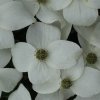 |
Cornus
kousa 'White Giant' The name says it all! Large overlapping white bracts almost obscure the foliage. 'White Giant' has good vigour, readily forming a traditional tree-like shape. Attractive flaky, defoliating bark is a feature of this cultivar and a real bonus. |
|
|
|
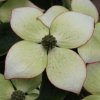 |
Cornus
kousa
var. chinensis 'Wieting's Select' Selected in Germany, this form is particularly hardy, with excellent reddish autumn colour. Masses of creamy white bracts are freely produced, followed by an excellent crop of fruit. This one will develop a comparatively broad, layered habit. See it in our Gardens here. |
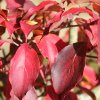 |
|
|
|
|
| Cornus
kousa var. chinensis
'Wisley Queen' Such is the esteem in which the magnificent specimen on Battleston Hill at the RHS Garden, Wisley is held, that it was eventually given a cultivar name. And this is that very plant. Statuesque and floriferous, with fabulous autumn colour. |
|
|
|
|
| Cornus
kousa 'Wolf Eyes' A variegated selection with strong white margins and subtle grey green centres to the leaf. Variegated Cornus kousa cultivars typically perform better with at least enough shade to protect them from the strongest sun. 'Wolf Eyes' is supposedly scorch resistant but I would only try growing it in full sun on really nice, moisture retentive soil (as always, not too wet in winter though!) |
|
|
|
|
| Cornus
wilsoniana
|
Cornus
wilsoniana 'White Jade' Cornus wilsoniana is a separate species, but I have included it here because it is sufficiently closely related to Cornus kousa that we use the same rootstock when we graft them. The foliage is very similar, but the flowers are quite different, being corymbs of tiny white flowers produced in June. Although it doesn't retain its foliage quite long enough to be truly classified as semi-evergreen, it does typically hold its leaves until at least Christmas. However, the reason for planting it is neither its flower or its foliage, its the bark. As the tree matures, the spectacular flaking, mottled bark is reminiscent of that of some Eucalyptus, inspiring its common name of "ghost dogwood". 'White Jade' is the only cultivar currently selected from this very special species; named in recognition of the predominant colours of the amazing mature bark. The original plant can be found at the renowned J. C. Raulston Arboretum in North Carolina, USA and is widely considered to be the "best" specimen in cultivation. We are very grateful to Mark Weathington for sharing propagation material to enable us to introduce this fabulous plant to gardeners in the UK. The photo to the left shows the bark starting to do its thing. This is a young tree, approximately 5 years old. |
| Back to Previous Page |